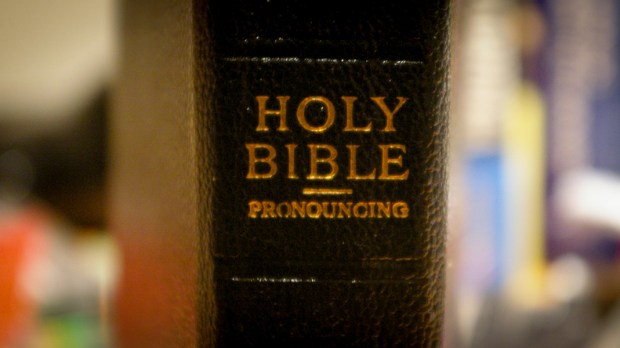Contrary to some caricatures, plenty of Catholics are very familiar with the Bible, but there are some of us who rarely open its pages, largely because we are unsure of how to approach and read holy Scripture.
Here is a hint: don’t open up to the book of Genesis and begin reading, intending to read it all the way through. It’s a rare person who can stick with it. The Bible is not a novel or a single narrative, and trying to read it straight through as though it were is a good way to guarantee that you’ll give up and never try again.
Some more good advice: playing “Bible Roulette” won’t do much for you, if you’re serious about reading scripture. We have all done it, of course — we’ve opened the book to a random page to “see what God has to say” to us. This practice may have had limited success with certain saints, but with this method the Bible will still remain a mystery to the modern Catholic; it won’t illuminate the rest of salvation history.
The proper approach to the Bible in an intentional one. It consists of using all available resources to plumb the depths of divine wisdom. In this way the Bible “comes alive” and can speak to our hearts. Here are three basic areas to consider when embarking on the lifelong journey of reading the Bible.
1. Bible Translation
One of the most important considerations to make is what type of translation you are hoping to read. In the biblical world, there are two main groups: literal and dynamic.
A literal translation is one where a team of translators worked tirelessly to render the Greek or Hebrew into an equivalent word in English. The result is a Bible that is extremely faithful to the original text but is sometimes difficult to read or understand.
Examples of this type of Bible include Revised Standard Version, Catholic Edition (RSV-CE) and Douay-Rheims.
To help correct the readability issues of literal translations, scholars and linguists worked together to produce Bibles that retained the meaning of the original passage, but were not exact translations. This means the English words are easier to read and understand, but the sacred author’s intent behind the word choice and sentence structure is often obscured.
Examples of dynamic bibles include New American Bible, Revised Edition (NAB-RE) and Jerusalem Bible (JB).
2. Commentaries
Besides selecting which type of translation you want to read, keep in mind the commentary that accompanies it — a more scholarly commentary may be of no use to a neophyte in the faith.
An easy to read commentary — one that include numerous articles about Catholic beliefs — is the Catholic Answer Bible. It clears up any confusion when it comes to Catholic teaching and addresses 88 topics.
A more scholarly biblical commentary is the Ignatius Catholic Study Bible: New Testament. This bible has extensive footnotes and is authored by Scott Hahn and Curtis Mitch. For those who want to go in-depth into specific bible passages, the Ignatius Catholic Study Bible is a great choice.
For those interested in a devotional commentary of scripture, the Navarre Bible is a perfect choice. This particular commentary is unique in that it has excerpts not only from Church Fathers and numerous Church documents, but also spiritual reflections by authors such as St. Josemaria Escriva.
3. Biblical Guides
Reading the Bible is a journey and it is important to have a “guide” accompany you. One popular guide is Jeff Cavins and he produced an excellent series called theBible Timeline. It helps the biblical novice make sense of it all and brings added clarity to obscure passages in scripture.
Another guide to take along is Dr. Timothy Gray, who has been opening up individual books of the New Testament in a new series called Lectio. He also does an excellent job breathing life into the ancient text of the Bible.
It is also important to read the Bible with the guidance of the Church. The Catechism of the Catholic Church contains specific instructions on how to approach the Bible in paragraphs 115-117.
In the end, reading the Bible is an adventure, one that everyone should embark on at some point during their life. The important thing to remember is to do so intentionally, making thoughtful preparations to make it a successful trip through the Word of God.

